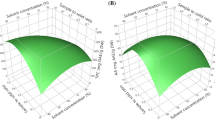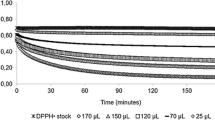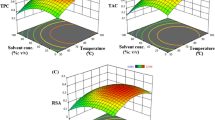Abstract
Turmeric is a spice widely used to enhance the taste and color of certain meats. We investigated the antioxidant capacities of turmeric ethanol soaking extracts by utilizing the scavenging properties of hydroxyl radical and 1,1-diphenyl-2-picrylhydrazyl (DPPH) free radical. The results showed that the optimum extraction parameters were: extraction time 4 h, sample-solvent ratio 1:84.12, solvent 72.34% ethanol solution, and water bath temperature 81.3 ℃. The optimum ethanol soaking extraction parameters were: extraction time 4 h, sample-solvent ratio 1:90.74, solvent 80.46% ethanol solution, water bath temperature 88.2 ℃. With these parameters, the hydroxyl radical scavenging rate and the DPPH free radical clearance of crude extracts from turmeric can reach about 93.78% and 40.69%, respectively. These results indicate that ethanol soaking extraction may be a useful method for extracting antioxidants from turmeric.
Similar content being viewed by others
References
Zhang Y W, Zhang H, Wang L, et al. Influence of the degree of hydrolysis (DH) on antioxidant properties and radical-scavenging activities of peanut peptides prepared from fermented peanut meal[J]. Eur Food Res Technol, 2011, 232(6): 941–950.
Gulcin I, Huyut Z, Elmastas M, et al. Radical scavenging and antioxidant activity of tannic acid[J]. AR J Chem, 2010, 3(1): 43–53.
Tsaliki E, Lagouri V, Doxastakis G. Evaluation of the antioxidant activity of lupin seed flour and deriatives (Lulinus albus ssp. Graecus)[J]. Food Chem, 1999, 65(1): 71–75.
Ahn G N, Kim K N, Cha S H, et al. Antioxidant activities of phlorotannins purified from Ecklonia cava on free radical scavenging using ESR and H2O2-mediated DNA damage[J]. Eur Food Res Technol, 2007, 226(1-2): 71–79.
Gulcin I. Antioxidant activity of food constituents: An overview[J]. Arch Toxicol, 2012, 86(3): 345–391.
Annegowda H V, Mordi M N, Ramanathan S, et al. Effect of extraction techniques on phenolic content, antioxidant and antimicrobial activity of Bauhinia purpurea: HPTLC determination of antioxidants[J]. Food Anal Methods, 2012, 5(2): 226–233.
Karmakar I, Dolai N, Saha P, et al. Scavenging activity of Curcuma caesia rhizome against reactive oxygen and nitrogen species[J]. Orient Pharm Exp Med, 2011, 11(4): 221–228.
Mohd N F, Mohamed S, Idris N A, et al. Antioxidative properties of Curcuma longa leaf extract in accelerated oxidation and deep frying studies[J]. J Am Oil Chem Soc, 2009, 86(2): 141–147.
Filip S, Pavlic B, Vidovic S, et al. Optimization of microwave-assisted extraction of polyphenolic compounds from Ocimum basilicum by response surface methodology[J]. Food Anal Methods, 2017, 10(7): 2270–2280.
Sogi D S, Sharma S, Oberoi D P S, et al. Effect of extraction parameters on curcumin yield from turmeric[J]. J Food Sci Technol, 2010, 47(3): 300–304.
Khanna N M. Turmeric-nature’s precious gift[J]. Current Science, 1999, 76: 1351–1356.
Lim H S, Park S H, Ghafoor K, et al. Quality and antioxidant properties of bread containing turmeric (Curcuma longa L.) cultivated in South Korea[J]. Food Chem, 2011, 124(4): 1577–1582.
Banerjee A, Ghosh S, Ghosh M. Anti-oxidative effect of turmeric on frying characteristics of soybean oil[J]. J Food Sci Technol, 2015, 52(3): 1760–1765.
Sikora E, Scapagnini G, Barbagallo M. Curcumin, inflammation, ageing and age-related diseases[J]. Immun Ageing, 2010, 7(1): 1–4.
Maheshwari R K, Singh A K, Gaddipati J, et al. Multiple biological activities of curcumin: A short review[J]. Life Sci, 2006, 78(18): 2081–2087.
Kim M H, Kim S I, Seo D W, et al. Antioxidant activity of Salvia miltiorrhiza Bunge, a novel foodstuff[J]. Mol Cell Toxicol, 2010, 6(1): 65–72.
Naz S, Jabeen S, Ilyas S, et al. Antibacterial activity of curcuma longa varieties against different strains of bacteria[J]. Pak J Bot, 2012, 42(1): 455–462.
Chainani W N. Safety and anti-inflammatory activity of curcumin: A component of turmeric (Curcuma longa)[J]. J Altern Complement Med, 2003, 9(1): 161–168.
Sharma R A, Gescher A J, Steward W P. Curcumin: The story so far[J]. Eur J Cancer, 2005, 41(13): 1955–1968.
Wickenberg J, Ingemansson S L, Hlebowicz J. Effects of Curcuma longa (turmeric) on postprandial plasma glucose and insulin in healthy subjects[J]. Nutrition Journal, 2010, 9(1):1–5.
Hussain A I, Chatha A S, Noor S, et al. Effect of extraction techniques and solvent systems on the extraction of antioxidant components from peanut (Arachis hypogaea L.) hulls[J]. Food Anal Methods, 2012, 5(4): 890–896.
Chen X Q. Experiment Method of Antioxidant Research[M]. Beijing: China Medical Science Press, 1996(Ch).
Jiang B, Zhang H Y, Liu C J, et al. Extraction of water-soluble polysaccharide and the antioxidant activity from Ginkgo biloba leaves[J]. Med Chem Res, 2010, 19(3): 262–270(Ch).
Author information
Authors and Affiliations
Corresponding author
Additional information
Foundation item: Supported by the National Natural Science Foundation of China (31401500), the Natural Science Foundation of Zhejiang Province ( LQ13C200005), and the Young Academic Team of Zhejiang Shuren University
Biography: LIU Caiqin, female, Associate professor, Ph.D., research direction: food science.
Rights and permissions
About this article
Cite this article
Liu, C., Chen, W., Wang, N. et al. Optimization of extraction of antioxidants from turmeric (Curcuma longa L.) using response surface methodology. Wuhan Univ. J. Nat. Sci. 23, 63–69 (2018). https://doi.org/10.1007/s11859-018-1295-0
Received:
Published:
Issue Date:
DOI: https://doi.org/10.1007/s11859-018-1295-0
Keywords
- turmeric
- ethanol soaking extraction
- antioxidant activity
- hydroxyl radical scavenging capacity
- 1,1-diphenyl-2- picrylhydrazyl (DPPH) scavenging capacity




